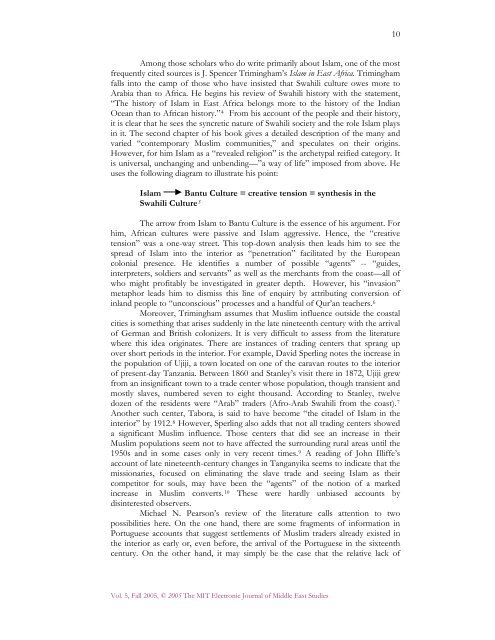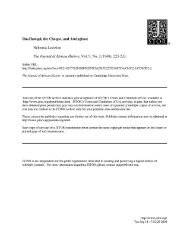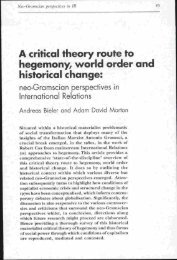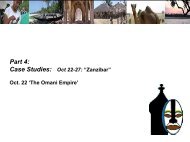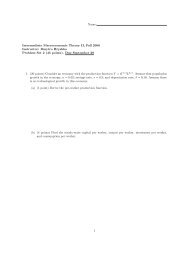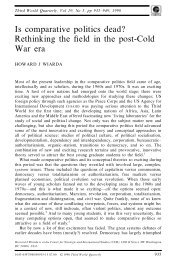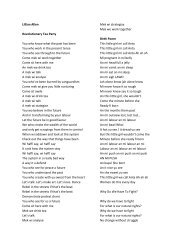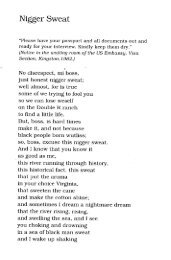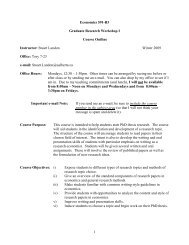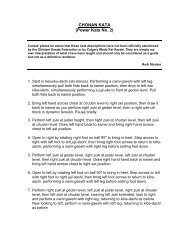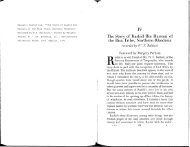personal memories revolutionary states and indian ocean migrations
personal memories revolutionary states and indian ocean migrations
personal memories revolutionary states and indian ocean migrations
You also want an ePaper? Increase the reach of your titles
YUMPU automatically turns print PDFs into web optimized ePapers that Google loves.
Among those scholars who do write primarily about Islam, one of the most<br />
frequently cited sources is J. Spencer Trimingham’s Islam in East Africa. Trimingham<br />
falls into the camp of those who have insisted that Swahili culture owes more to<br />
Arabia than to Africa. He begins his review of Swahili history with the statement,<br />
“The history of Islam in East Africa belongs more to the history of the Indian<br />
Ocean than to African history.” 4 From his account of the people <strong>and</strong> their history,<br />
it is clear that he sees the syncretic nature of Swahili society <strong>and</strong> the role Islam plays<br />
in it. The second chapter of his book gives a detailed description of the many <strong>and</strong><br />
varied “contemporary Muslim communities,” <strong>and</strong> speculates on their origins.<br />
However, for him Islam as a “revealed religion” is the archetypal reified category. It<br />
is universal, unchanging <strong>and</strong> unbending—”a way of life” imposed from above. He<br />
uses the following diagram to illustrate his point:<br />
Islam Bantu Culture = creative tension = synthesis in the<br />
Swahili Culture 5<br />
The arrow from Islam to Bantu Culture is the essence of his argument. For<br />
him, African cultures were passive <strong>and</strong> Islam aggressive. Hence, the “creative<br />
tension” was a one-way street. This top-down analysis then leads him to see the<br />
spread of Islam into the interior as “penetration” facilitated by the European<br />
colonial presence. He identifies a number of possible “agents” -- “guides,<br />
interpreters, soldiers <strong>and</strong> servants” as well as the merchants from the coast—all of<br />
who might profitably be investigated in greater depth. However, his “invasion”<br />
metaphor leads him to dismiss this line of enquiry by attributing conversion of<br />
inl<strong>and</strong> people to “unconscious” processes <strong>and</strong> a h<strong>and</strong>ful of Qur’an teachers. 6<br />
Moreover, Trimingham assumes that Muslim influence outside the coastal<br />
cities is something that arises suddenly in the late nineteenth century with the arrival<br />
of German <strong>and</strong> British colonizers. It is very difficult to assess from the literature<br />
where this idea originates. There are instances of trading centers that sprang up<br />
over short periods in the interior. For example, David Sperling notes the increase in<br />
the population of Ujiji, a town located on one of the caravan routes to the interior<br />
of present-day Tanzania. Between 1860 <strong>and</strong> Stanley’s visit there in 1872, Ujiji grew<br />
from an insignificant town to a trade center whose population, though transient <strong>and</strong><br />
mostly slaves, numbered seven to eight thous<strong>and</strong>. According to Stanley, twelve<br />
dozen of the residents were “Arab” traders (Afro-Arab Swahili from the coast). 7<br />
Another such center, Tabora, is said to have become “the citadel of Islam in the<br />
interior” by 1912. 8 However, Sperling also adds that not all trading centers showed<br />
a significant Muslim influence. Those centers that did see an increase in their<br />
Muslim populations seem not to have affected the surrounding rural areas until the<br />
1950s <strong>and</strong> in some cases only in very recent times. 9 A reading of John Illiffe’s<br />
account of late nineteenth-century changes in Tanganyika seems to indicate that the<br />
missionaries, focused on eliminating the slave trade <strong>and</strong> seeing Islam as their<br />
competitor for souls, may have been the “agents” of the notion of a marked<br />
increase in Muslim converts. 10 These were hardly unbiased accounts by<br />
disinterested observers.<br />
Michael N. Pearson’s review of the literature calls attention to two<br />
possibilities here. On the one h<strong>and</strong>, there are some fragments of information in<br />
Portuguese accounts that suggest settlements of Muslim traders already existed in<br />
the interior as early or, even before, the arrival of the Portuguese in the sixteenth<br />
century. On the other h<strong>and</strong>, it may simply be the case that the relative lack of<br />
Vol. 5, Fall 2005, © 2005 The MIT Electronic Journal of Middle East Studies<br />
10


